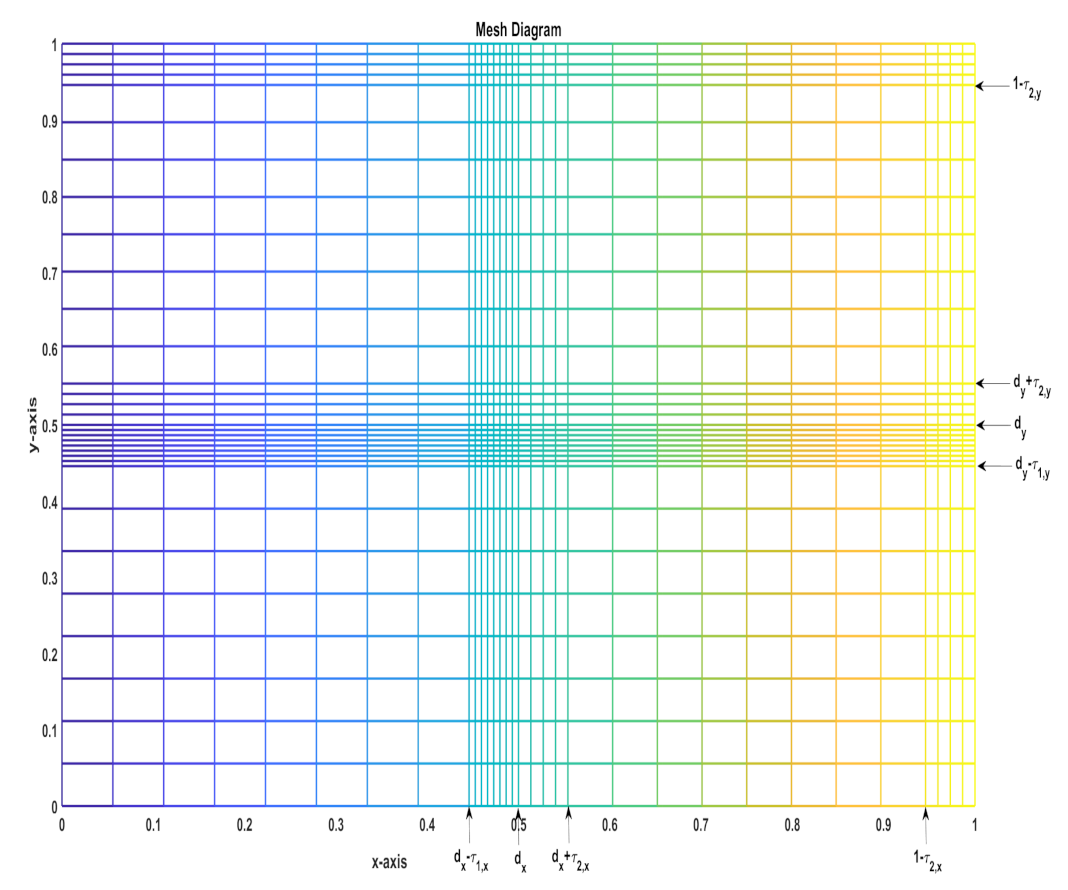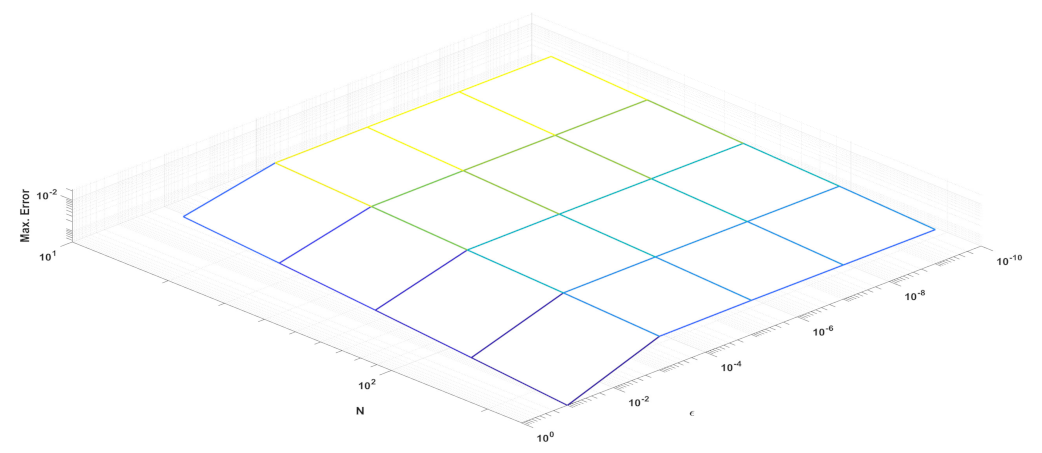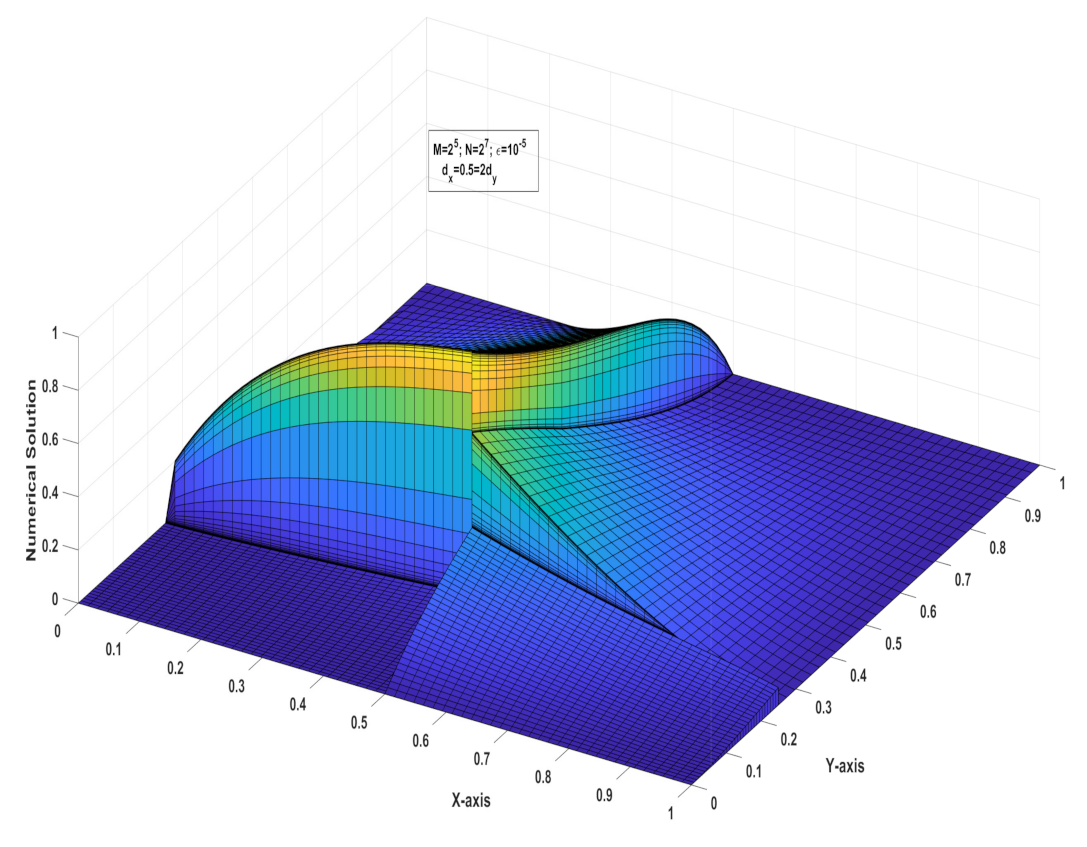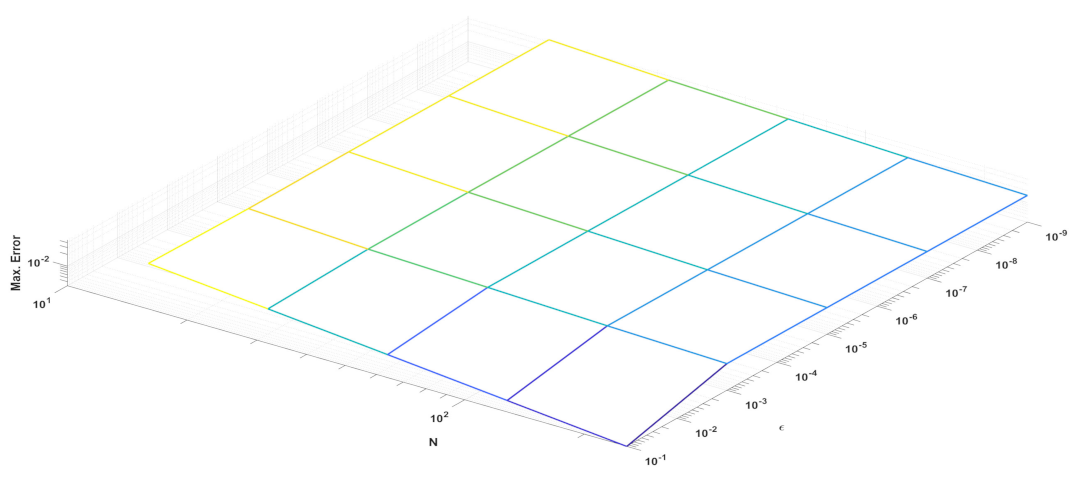1. Introduction
Differential equations with small or large parameters can be used to describe a variety of applied practical problems, including the theory of boundary layers. For example, the shock waves occurring in gas motions, edge effects when elastic plates deform, etc. These mathematical problems are very difficult (or even impossible) to solve exactly, so approximate solutions are necessary. It is possible to obtain an approximation of the solution through perturbation methods. Basically, these methods aim to solve a simpler problem (as a first approximation) and systematically improve the approximate solution.
When using finite difference or finite element methods on equally spaced grids and allowing the perturbation parameter tend to zero, boundary layers produce inaccurate numerical solutions. The most popular method for overcoming this difficulty is to construct uniformly valid numerical methods on layers adapted to the mesh. There are several uniformly valid methods available in the literature, for instance, to cite a few (see Refs. [
1,
2] and the references therein). As pointed out in Ref. [
3], the direct discretization of the singularly perturbed 2D parabolic differential equations leads to a pentadiagonal linear system of equations. This problem is exceedingly complex to solve computationally. We use the fractional step method in order to reduce the computation cost. At each time level, the fractional step method leads to the tridiagonal system of algebraic equations. Several types of research have been conducted recently on the fractional step method, such as Refs. [
4,
5,
6] and the references therein.
Singularly perturbed delay differential equations (SPDDEs) are a class of perturbation problems with at least one delay or deviating argument. This type of problem occurs frequently in the modelling of various types of physical and biological problems. For example, the neuronal variability and its theoretical analysis have been modelled as delay parabolic equations [
7,
8]. Asymptotic analyses for 1D stationery SPDDEs have been well studied by Lange and Miura [
9]. Several numerical methods for SPDDEs of 1D stationery problems have been reported in the literature, such as Refs. [
10,
11,
12,
13] and the reference therein. The numerical method for 1D parabolic equations was initiated by Ref. [
14] and it gained the interest of many researchers. Das and Natesan [
15] presented computing techniques for solving 2D time SPDDEs. Ref. [
16] presented some applications and existence results for partial delay differential equations. The modelling of option pricing, to generalize the celebrated Black–Scholes equation with suitable weight, led to the 2D parabolic differential equations with space shift [
17]. We consider discontinuous convection and source terms in 2D parabolic SPDDEs in this article, as mentioned in the abstract. This problem exhibits interior layers at
and
and, due to the presents of the shift in space, the boundary layers occurs at
and
. The existence results pertaining to the parabolic equation with discontinuous coefficients are addressed in Ref. [
18]. The method presented in this article is a combination of the layers adopted technique and linear interpolations. The interpolation term takes care of the delay arguments. The proposed method is validated theoretically and numerically to be uniformly convergent in both space and time by considering some numerical examples.
The constant C is generic positive, that is, it is independent of the perturbation parameter as well as the discretization parameters N and M throughout the paper. For convenience, it is assumed that the number of mesh points in the spatial domains and are same, that is, N and the index set for any positive integer It is conventional to assume for the convection coefficient problem that for practical purposes. Further, to measure the error bounds and derivative bounds, we use the following norm
The article is organized as follows: the problem is considered in
Section 2. The fractional implicit Euler method for time derivative and locally 1D problems are presented in
Section 3. In the same section, the stability results and derivative estimates of the locally one-dimensional problems are presented.
Section 4 presents the numerical method for the considered problem. The discretizations incurred by the errors are estimated in
Section 5. Numerical validations through some test example problems are done in
Section 6. Finally, in
Section 7, some concluding remarks are made.
4. Discrete Problem
4.1. Spatial Domain Discretization
From Theorems 1 and 2, we observe that the IBVP (
1)–(3) exhibits twin interior layers along the lines
and
and weak boundary layers along
and
. Let
N be the number of mesh points in both spatial
x and
y directions. As the mesh defined in Ref. [
13], we define the mesh points in both
x and
y directions, which is given in the following: let
,
,
and
. Using the transition parameters
, we partitioned the domains
and
as follows:
On each sub-domains
, respectively, we place
mesh points with mesh sizes
,
,
,
,
. In the same manner the mesh points in
are defined. Now let us denote the mesh sizes to be
and
and define the mesh
,
and
,
The mesh distribution is depicted in the
Figure 1.
4.2. The Finite Difference Schemes
On the meshes and , we define the following finite difference schemes.
fix
,
fix
,
where
and
are the standard finite difference operators,
, ,
, , are the nodal points such that and The above two difference operators and satisfy the following discrete maximum principles.
Note: Let us denote the difference operators and In the following we use the above difference operators. Further, the test functions and are also used.
4.3. Discrete Stability Results
Lemma 4. Let the mesh function be , satisfies , and , then for all
Proof. Making use of the test mesh function
and the arguments given in Ref. [
13], Lemma 6.1, the lemma can be proved. □
Lemma 5. Let the mesh function be , satisfies , and , then for all
Using the above two Lemmas 4 and 5, we can have the following discrete stability results.
Lemma 6. Let be a numerical solution defined by (16), then Lemma 7. Let be a numerical solution defined by (17), then Remark 1. From Lemmas 6 and 7, we can see that, the numerical solutions defined in (16) and (17) are stable. Further, by the results of Ref. [20], the matrices associated with the difference schemes (16) and (17) are M-matrices. 5. Error Computation
Analogous to the continuous solution, the numerical solution is decomposed into smooth and singular components. The solution
is decomposed as
satisfy the following difference equations:
Similarly, the solution
is decomposed as
and they satisfy the following difference equations:
Note: The error estimate in each time level is proved in the following way:
Step 1 : First we estimate the absolute difference of U and V;
Step 2 : We estimate the error bound of the regular component, that is ;
Step 3 : To estimate the error bound of the singular component in the entire domain, first we estimate in the outer region and then using the estimate of , we estimate in the inner layer region;
Step 4 : Using the triangle inequality, we estimate the error bound of the numerical solution in each time level.
Lemma 8. Let and be numerical solutions of (16) and (18), respectively, when , then ζ is constant.
Proof. Fix
j. Let us consider the mesh function
where
, and
It is easy to show that
and by the arguments of [
13], we have
By the Lemma 4, we have Hence the proof of the lemma. □
Lemma 9. Let and be two solutions of (12) and (18), respectively, the Proof. Now, we see that
from the results given in Refs. [
2,
21,
22], we have
Using the following barrier function
we can see that
,
and
From the Lemma 4, we have the desired result. □
Lemma 10. Let and be the solutions of (13) and (19), respectively, then Proof. By the triangle inequality, Theorem 1, Lemmas 8 and 9, we have
where
. Hence
Therefore
To prove the result inside the inner region, we consider the following mesh function
where
,
Then we have,
Further
Now,
for a suitable choice of
At the point
, we have
From the Lemma 4, we have
,
. Therefore
□
Lemma 11. Let and be the solution of (5) and (16), respectively, then Proof. The proof follows from the above two lemmas. □
Lemma 12. Let , , , , , and be the solutions of (14), (15), (6), (20), (21), and (17), respectively, then Proof. We see that, and .
Similar to the proof of Lemma 8, we can prove the following,
Let
and
be the solutions of (
14) and (
20), then similar to Lemma 9, we have
and
Then by a suitable barrier function one can prove that
Similar to the Lemma 11, we estimate
Hence
and
Using the barrier function
where
,
we prove that
Hence the proof. □
Theorem 3. Let , , and be the solutions of (5), (6), (16), and (17), respectively, then Proof. We prove the theorem on each time level
. We know that
,
,
and
.
with the successive applications of Lemmas 6 and 7 and the iteration in
n, we prove that
Using the following barrier functions
and from Lemmas 6 and 7, we can prove that
It is observed that
. Using the following barrier functions
where
, we prove that and . By the triangle inequality, we have the desired results. □
Theorem 4. Let and be the solutions of (1) and (17), then Proof. The error can be obtained from the following
From Lemma 3, Theorem 3 and Ref. [
6], Theorem 1, we have
which completes the proof. □
7. Concluding Remarks
This article discusses singularly perturbed 2D parabolic delay differential equations with discontinuous convection coefficients and source terms. As pointed out in Ref. [
3], the fractional step method results in low-cost computation for 2D problems. Therefore, we first apply the fractional implicit Euler method for the time derivative. Then the higher dimensional problem is reduced to lower dimensional problems. In fact, we get
system of uncoupled equations. Each equation is a singularly perturbed differential equation with a discontinuous convection coefficient and source term. As discussed in Ref. [
13], we discretized the spatial domains
in the same manner, such as
. On each mesh we apply the difference scheme
It is proved that the present method is of almost first-order convergence in space and time.
Figure 2 and
Figure 4 represent the test problems solutions stated in Examples 1 and 2, respectively, we see that, the layers occurs at the points
and
.
Table 1 and
Table 2 present the maximum pointwise errors of the test example problems. It is also worth noting that when the parameter
drops, the maximum pointwise error grows and stabilizes. It is assumed that the number of mesh points in the time direction is
. From
Figure 3 and
Figure 5 we see that the maximum pointwise error decreases as
N increases. The present method works for the problems with any delay arguments of size
In Example 1 we assumed that
, whereas in Example 2 we assumed that













